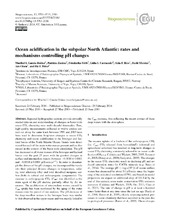| dc.contributor.author | García-Ibáñez, Maribel I. | |
| dc.contributor.author | Zunino, Patricia | |
| dc.contributor.author | Fröb, Friederike | |
| dc.contributor.author | Carracedo, Lidia I. | |
| dc.contributor.author | Ríos, Aida F. | |
| dc.contributor.author | Mercier, Herlé | |
| dc.contributor.author | Olsen, Are | |
| dc.contributor.author | Pérez, Fiz F. | |
| dc.date.accessioned | 2017-08-18T12:00:05Z | |
| dc.date.available | 2017-08-18T12:00:05Z | |
| dc.date.issued | 2016-06-23 | |
| dc.identifier.issn | 1726-4189 | en_US |
| dc.identifier.issn | 1726-4170 | en_US |
| dc.identifier.uri | https://hdl.handle.net/1956/16362 | |
| dc.description.abstract | Repeated hydrographic sections provide critically needed data on and understanding of changes in basin-wide ocean CO2 chemistry over multi-decadal timescales. Here, high-quality measurements collected at twelve cruises carried out along the same track between 1991 and 2015 have been used to determine long-term changes in ocean CO2 chemistry and ocean acidification in the Irminger and Iceland basins of the North Atlantic Ocean. Trends were determined for each of the main water masses present and are discussed in the context of the basin-wide circulation. The pH has decreased in all water masses of the Irminger and Iceland basins over the past 25 years with the greatest changes in surface and intermediate waters (between −0.0010 ± 0.0001 and −0.0018 ± 0.0001 pH units yr−1). In order to disentangle the drivers of the pH changes, we decomposed the trends into their principal drivers: changes in temperature, salinity, total alkalinity (AT) and total dissolved inorganic carbon (both its natural and anthropogenic components). The increase in anthropogenic CO2 (Cant) was identified as the main agent of the pH decline, partially offset by AT increases. The acidification of intermediate waters caused by Cant uptake has been reinforced by the aging of the water masses over the period of our analysis. The pH decrease of the deep overflow waters in the Irminger basin was similar to that observed in the upper ocean and was mainly linked to the Cant increase, thus reflecting the recent contact of these deep waters with the atmosphere. | en_US |
| dc.language.iso | eng | eng |
| dc.publisher | European Geosciences Union | en_US |
| dc.relation.ispartof | <a href="http://hdl.handle.net/1956/16357" target="blank">Climate controlled mechanisms of subpolar North Atlantic carbon uptake</a> | en_US |
| dc.rights | This work is distributed under the Creative Commons Attribution 3.0 License. | eng |
| dc.rights.uri | https://creativecommons.org/licenses/by/3.0/ | eng |
| dc.title | Ocean acidification in the subpolar North Atlantic: rates and mechanisms controlling pH changes | en_US |
| dc.type | Peer reviewed | |
| dc.type | Journal article | |
| dc.description.version | publishedVersion | en_US |
| dc.rights.holder | Copyright the authors. | en_US |
| dc.identifier.doi | https://doi.org/10.5194/bg-13-3701-2016 | |
| dc.source.journal | Biogeosciences | |
| dc.source.40 | 13 | |
| dc.subject.nsi | VDP::Matematikk og Naturvitenskap: 400::Geofag: 450 | en_US |

